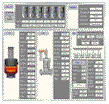|
||||||
|
|
(Note: It is for the book published (can be purchased from Bookstore, etc.). For
short, I provide several points: 1. The finite element method finds today more and more applications in the simulation, planning and optimization of metal forming processes. This is due to the high demand on product quality and low production costs in the steel industry, as well as the rapid advances in the performance of hard- and software computers and the simultaneously dramatic fall in prices of the hardware. Few studies however, exist which adequately apply this method to complicated shape rolling due to the numerous difficulties involved. The aim of this work is to investigate, based on experimental results of force and power requirements and the local material flow of the angle steel rolling, the performance capability of FEM and the possibilities of its practical application to metal forming processes, especially in shape rolling processes. 2. During shape rolling, there exists a complicated distribution of local forming parameters in the roll gap. This results from the different roll diameters and uneven reduction over the section width, as well as the occurrence of inclination of the rolling path against the roll axis. With an increase in the inclination angle, the portion of indirect rolling force grows larger, and as a result, the spread increases. The distribution of normal and tangential stresses at the interface of the workpiece/roll also gets very intricate during rolling. A lateral flow of material exists from where the reduction is larger towards the zone with relative less reduction. The empirical calculation of the rolling force and rolling torque of shape rolling can be done according to the dependence of deforming resistance Kwm/Kfm and lever arm coefficient l on the area coefficient Ad/Am (ratio of deformation zone area to mean cross section area). The area of deformation zone can be determined using various methods, such as the slab model. In the slab model method, the width of a section is at first separated into a number of portions. For each portion a partial area of deformation zone can be calculated just like in flat rolling. The sum of all partial areas gives the area of deformation. The mean temperature of the workpiece after rolling can be decided according to the heat balance of the workpiece and the roll considering the heat generated by mechanical work during the rolling.
Part 1 | Part 2 | Part 3 | Part 4 | Part 5 | Part 6 | Part 7 | Part 8 | Part 9 | Part 10 | Part 11 | Part 12
|
|||||
|
||||||
